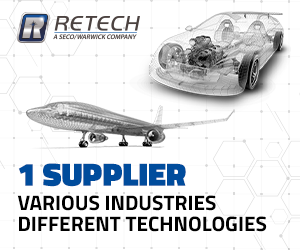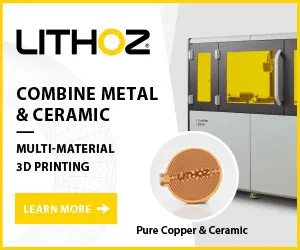JPMA Award Winners 2011
The winners of the Japan Powder Metallurgy Association (JPMA) 2011 Powder Metallurgy Awards highlight the capabilities of PM and demonstrate the continuing advances of Japan’s PM industry. Many of the winners are evidence of the continuing potential for PM applications in the automotive industry.
< See award archive
New Design Category
Low Noise Sintered Gear
Porite Corp
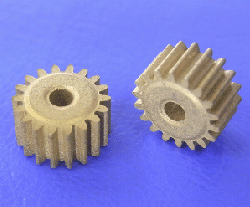 Porite Corp. received two JPMA Awards in this category. The first was for the development of a new low noise sintered gear used in the motor pinion of a multifunction home office printer, copy machine and scanner. The sintered metal gear replaced a plastic one into which had been inserted a porous self-lubricating bearing and which was then fitted onto the motor shaft.
Porite Corp. received two JPMA Awards in this category. The first was for the development of a new low noise sintered gear used in the motor pinion of a multifunction home office printer, copy machine and scanner. The sintered metal gear replaced a plastic one into which had been inserted a porous self-lubricating bearing and which was then fitted onto the motor shaft.
The sintered gear, which is produced from iron powder coated with bronze, is produced to low density and combines the benefit of a self lubrication bearing with low operational noise and good strength of the sintered gear. The low noise of the sintered part was achieved by ensuring the dimensional accuracy of the gears. This required tooling designed specifically for the bronze-coated iron powders, optimising sintering conditions to suppress dimensional variations, and final sizing of the gears.
Oil Impregnated Sintered Bearing
Porite Corp
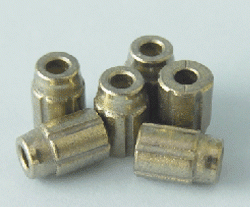 The second JPMA Award presented to Porite Corp in the New Design Category was for an oil impregnated sintered bearing designed for an ultra-high speed scanner motor used in a laser beam printer (LBP). The LBP scanner motor has been reduced in size and has been speeded up to improve the performance of the laser printer.
The second JPMA Award presented to Porite Corp in the New Design Category was for an oil impregnated sintered bearing designed for an ultra-high speed scanner motor used in a laser beam printer (LBP). The LBP scanner motor has been reduced in size and has been speeded up to improve the performance of the laser printer.
A fluid dynamic bearing, or air bearing, is normally specified for the required speed range of the motor; however, Porite succeeded in developing a sintered self-lubricating bearing which offered reduced wear under loading as well as providing a sufficient oil lubricating film to control friction loss during high speed rotation. The company designed the bearing’s sliding surface to be longer in order to reduce jitter and vibration caused during running of the bearing in the small sized motor at high speed.
The company also adjusted the top and bottom sliding surface length to even the load on each surface. The permeability of the porous material was also reduced in order to control friction loss and improve crushing strength of the matrix compared with the previously used material but at the same level of oil content.
Sinter Diffusion Bonded Carrier for a High Torque Transfer Mechanism
Hitachi Chemical Co Ltd
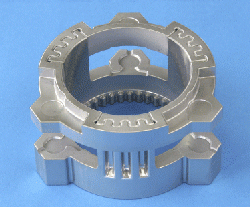 Hitachi Chemical Co Ltd received an award in this category for a reduced weight sinter diffusion bonded carrier for a high torque transfer mechanism used for changing from High mode to Low mode in a 4WD transmission.
Hitachi Chemical Co Ltd received an award in this category for a reduced weight sinter diffusion bonded carrier for a high torque transfer mechanism used for changing from High mode to Low mode in a 4WD transmission.
The reduced cost, lightweight carrier is produced by assembling the different PM components using an angle direction assembly method prior to diffusion bonding instead of radial direction assembly. This was said to improve the bonding strength in the diffusion bonded area of the new transfer carrier, as well as weight reduction by eliminating unnecessary material. The company stabilized the compacting of the long part (68.3 mmL) using a high performance lubricant and water-cooled die.
Sintered Base Valve Seat
Fine Sinter Co Ltd
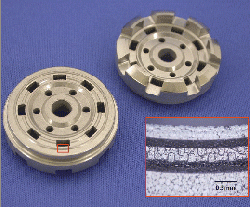 Fine Sinter Co Ltd received an Award in the New Design Category for a sintered base valve seat used in shock absorbers for automobiles. This PM product is required to reduce the contact area between the seat face and valve due to both oil viscosity and geometry of the seat face. This is normally achieved by additional machining after sizing of the PM part. However, Fine Sinter has been able to achieve improved precision of the part through appropriate material selection, improved powder compacting process, and sintering method.
Fine Sinter Co Ltd received an Award in the New Design Category for a sintered base valve seat used in shock absorbers for automobiles. This PM product is required to reduce the contact area between the seat face and valve due to both oil viscosity and geometry of the seat face. This is normally achieved by additional machining after sizing of the PM part. However, Fine Sinter has been able to achieve improved precision of the part through appropriate material selection, improved powder compacting process, and sintering method.
The geometry of the independent fine concave structure is open to the outside or inside toward either end of the seat face, and is alternately placed on the face to ensure seat face precision (step difference, flatness, and geometrical dimension). The company has been able to reduce manufacturing costs for the base valve seat face with leaf valve adsorption system by eliminating additional machining and by simplifying inspection processes.
Thrust Plate for a Variable Valve Timing (VVT) System
Diamet Corp.
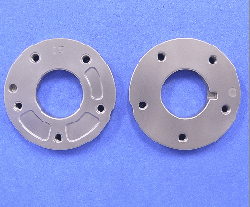 Diamet Corp. received two Awards in the New Design Category. The first is a PM thrust plate for a variable valve timing (VVT) system to improve fuel consumption and reduce exhaust gas emissions. PM technology has succeeded in replacing a thrust plate previously produced by sheet metal working through cost reduction. The assembled face of the thrust plate with the housing is usually ground to secure high flatness for sealing.
Diamet Corp. received two Awards in the New Design Category. The first is a PM thrust plate for a variable valve timing (VVT) system to improve fuel consumption and reduce exhaust gas emissions. PM technology has succeeded in replacing a thrust plate previously produced by sheet metal working through cost reduction. The assembled face of the thrust plate with the housing is usually ground to secure high flatness for sealing.
Diamet has achieved the required flatness criteria, which is as good as that achieved by a grinding finish, without any finishing by the optimization of the production process, such as filling, compaction, sintering, and sizing.
The company was also able to incorporate the holes for the lock pins on the face opposite to the assembled face, and the groove for locking the adjusting spring on the assembled face into the PM thrust plate. Because the holes for the lock pins are blind holes formed by punches, the structure and the material of the tools are optimized for tool life. The groove for locking the adjusting spring is shaped with a stepped core rod.
Part for the Angle Adjustment Mechanism used for Reclining Car Seats
Diamet Corp.
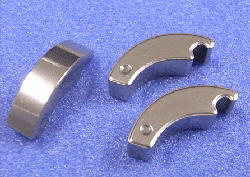 The second award given to Diamet in this category was for a PM part made from a heat treated Fe-Ni-Cu-Mo-C steel powder to satisfy criteria for strength and hardness in a sintered angle adjustment mechanism used for reclining seats in cars. The net shape PM component is required to have high hardness and a smooth surface to ensure angle regulation during reclining of the car seat.
The second award given to Diamet in this category was for a PM part made from a heat treated Fe-Ni-Cu-Mo-C steel powder to satisfy criteria for strength and hardness in a sintered angle adjustment mechanism used for reclining seats in cars. The net shape PM component is required to have high hardness and a smooth surface to ensure angle regulation during reclining of the car seat.High dimensional precision of the PM part is obtained by the optimization of the steel powder and filling, and the adoption of two piece compaction of the asymmetric shaped part. The surface smoothness is assured by optimization of the barrelling conditions, such as tumbling media, processing time, and throughput. The sintered angle adjustment part is produced at a lower price and better surface smoothness than wrought steel parts.
New Materials Category
Corrosion Resistant Porous Bearing Material
Diamet Corp.
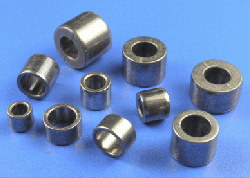 Diamet Corp received the Award in the New Materials Category for the development of a corrosion resistant porous bearing material for use in petrol pumps used in automobiles supplied to the global market. The new PM bearing material is based on Cu-Ni matrix for resistance to sulphuration due to high sulphur content found in some petrol in global markets, and Sn-rich network for resistance to organic acid.
Diamet Corp received the Award in the New Materials Category for the development of a corrosion resistant porous bearing material for use in petrol pumps used in automobiles supplied to the global market. The new PM bearing material is based on Cu-Ni matrix for resistance to sulphuration due to high sulphur content found in some petrol in global markets, and Sn-rich network for resistance to organic acid.
The chemical composition and processing conditions have been optimised for producing a sintered bearing which shows not only superior corrosion resistance when exposed to petrol containing high sulphur and organic acid concentration, but also has excellent tribological properties compared with conventional bronze bearings.
Process Development Category
Sintered Bearings Incorporating Grooves on the Outer Surface Without the Need for Machining
Diamet Corp.
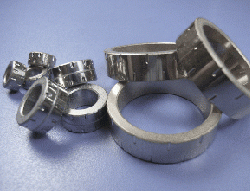 Diamet Corp. received an award in the Process Development category for the development of a method to produce sintered bearings having grooves on the outer surface without the need for machining. The grooves are used to increase the contact area between the bearing and the resin housing into which they are fitted. Perfectly passing through grooves are normally formed in the axial direction on the sintered bearing by compaction to prevent rotation, and some are formed in the circumferential direction by machining. This prevents the sintered bearings from falling out of the resin housing by the thrust force.
Diamet Corp. received an award in the Process Development category for the development of a method to produce sintered bearings having grooves on the outer surface without the need for machining. The grooves are used to increase the contact area between the bearing and the resin housing into which they are fitted. Perfectly passing through grooves are normally formed in the axial direction on the sintered bearing by compaction to prevent rotation, and some are formed in the circumferential direction by machining. This prevents the sintered bearings from falling out of the resin housing by the thrust force.
In the production method developed by Diamet, partial straight grooves are formed in the axial direction from one face end, and from the other face end alternately by sizing. The company has optimised the design of the groove to minimize scaling and wear of the sizing tools. Additionally, another method to increase resistance to thrust force was developed by utilizing convex section on the outer surface of sintered bearing. The result is a substantial cost reduction in the production of PM bearings with external grooves.
Effort Prize Category
Components used in a High Response VVT with New Intermediate Locking Mechanism
Sumitomo Electric Industries Ltd
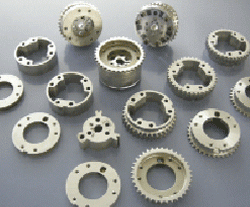 Sumitomo Electric Industries Ltd received an Award in the Effort Prize Category for a number of PM components used in a high response VVT (variable valve timing) with new intermediate locking mechanism. The PM parts comprise three sprockets, three housing-sprockets, three inner-plates, two housings and rotor.
Sumitomo Electric Industries Ltd received an Award in the Effort Prize Category for a number of PM components used in a high response VVT (variable valve timing) with new intermediate locking mechanism. The PM parts comprise three sprockets, three housing-sprockets, three inner-plates, two housings and rotor.
The main points in the development of the PM parts include induction hardening of locked-pin hole (rotor, housing-sprocket) in order to meet the wear resistance properties required for the locked-pin hole of rotor and housing-sprocket. This means that the steel bush normally press-fitted into this hole in conventional units could be omitted by applying a partial induction hardening method to the locked-pin hole.
It was also possible to eliminate the sizing of the inner plate by optimization of sintering process using special jigs (ceramic plates). Finally, the complicated shape oil groove on the end face of the high functional rotor was formed by net shape compacting and helped to reduce the total number of parts in the locking mechanism. As a result, high response VVT components were developed at lower cost than competing technologies.
Oil-Impregnated Bronze or Iron-Copper Sintered Bearings
Porite Corp.
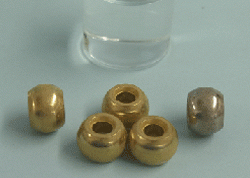 Also in the Effort Prize category was an Award given to Porite Corp. for an oil-impregnated bronze or iron-copper sintered bearings used in a motor for circulating hot air inside a home microwave appliance. In order to improve thermal efficiency and compactness, the position of impeller used to circulate the air is moved from outside to inside of the cooking space on the microwave oven. This exposes a portion of the PM bearing portion to heat and the conventional oil-impregnated bearing failed to ensure durability.
Also in the Effort Prize category was an Award given to Porite Corp. for an oil-impregnated bronze or iron-copper sintered bearings used in a motor for circulating hot air inside a home microwave appliance. In order to improve thermal efficiency and compactness, the position of impeller used to circulate the air is moved from outside to inside of the cooking space on the microwave oven. This exposes a portion of the PM bearing portion to heat and the conventional oil-impregnated bearing failed to ensure durability.
Porite has therefore developed a sintered bearing that can be used at 150C by selecting a silicon-based impregnation oil capable of operating at this temperature. This is cheaper than fluorine oil that is normally used for high temperature, bronze or iron copper bearing materials. Silicon oil has a lower surface tension, optimizing air permeability to hold the bearing oil film and to prevent oil-leakage. A special shape of the inner chamfer of the PM bearing can be used as an oil sump. The clearance of the bearing and shaft has been successfully endurance tested for high temperature operation for 2000 hrs.
For more information please visit the JPMA website






